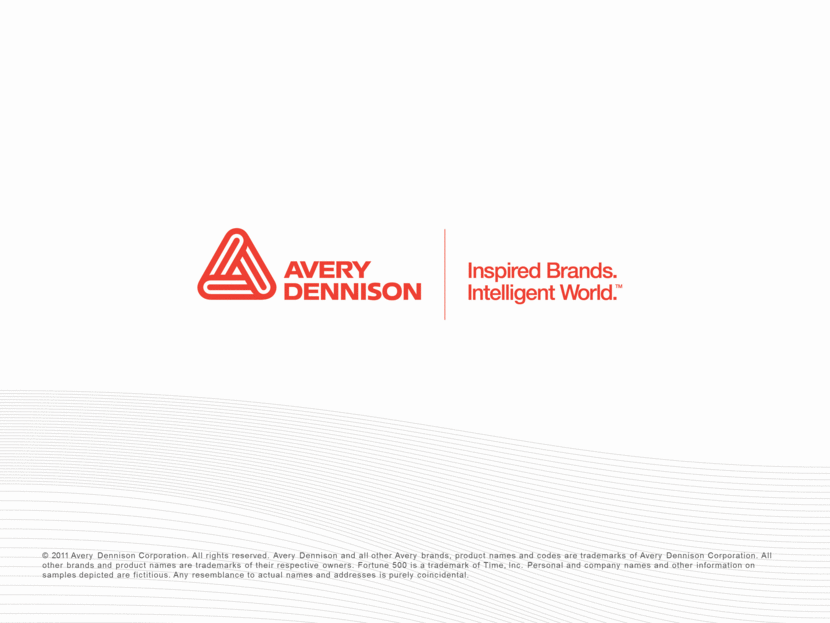Attached files
| file | filename |
|---|---|
| EX-99.1 - EX-99.1 - Avery Dennison Corp | a16-20383_1ex99d1.htm |
| 8-K - 8-K - Avery Dennison Corp | a16-20383_18k.htm |
Exhibit 99.2
Third Quarter 2016 Financial Review and Analysis (preliminary, unaudited) Supplemental Presentation Materials Unless otherwise indicated, comparisons are to the same period in the prior year. October 26, 2016
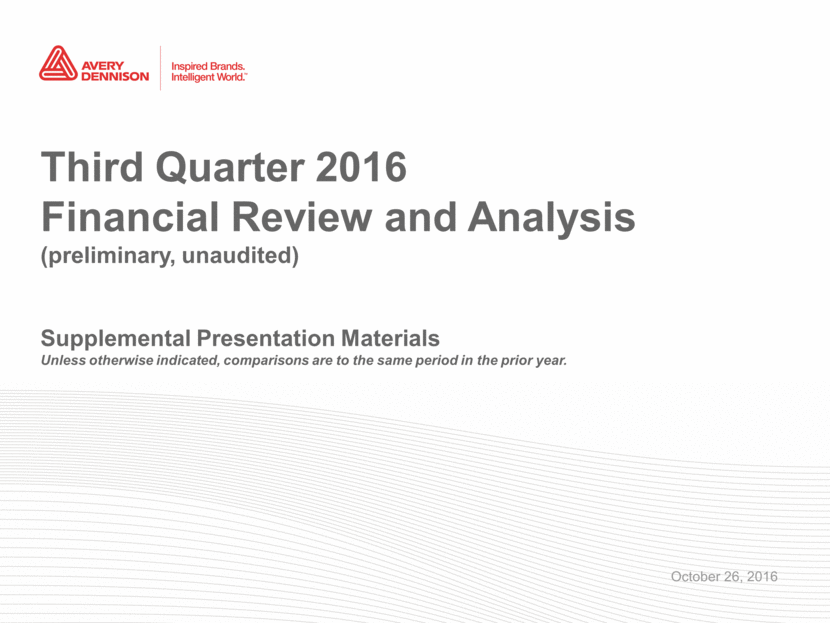
Certain statements contained in this document are "forward-looking statements" intended to qualify for the safe harbor from liability established by the Private Securities Litigation Reform Act of 1995. These forward-looking statements, and financial or other business targets, are subject to certain risks and uncertainties. Actual results and trends may differ materially from historical or anticipated results depending on a variety of factors, including but not limited to risks and uncertainties relating to the following: fluctuations in demand affecting sales to customers; worldwide and local economic conditions; fluctuations in currency exchange rates and other risks associated with foreign operations, including in emerging markets; the financial condition and inventory strategies of customers; changes in customer preferences; fluctuations in cost and availability of raw materials; our ability to generate sustained productivity improvement; our ability to achieve and sustain targeted cost reductions; the impact of competitive products and pricing; loss of significant contracts or customers; collection of receivables from customers; selling prices; business mix shift; timely development and market acceptance of new products, including sustainable or sustainably-sourced products; investment in development activities and new production facilities; integration of acquisitions and completion of potential dispositions; amounts of future dividends and share repurchases; customer and supplier concentrations; successful implementation of new manufacturing technologies and installation of manufacturing equipment; disruptions in information technology systems, including cyber-attacks or other intrusions to network security; successful installation of new or upgraded information technology systems; data security breaches; volatility of financial markets; impairment of capitalized assets, including goodwill and other intangibles; credit risks; our ability to obtain adequate financing arrangements and maintain access to capital; fluctuations in interest and tax rates; changes in tax laws and regulations, and uncertainties associated with interpretations of such laws and regulations; outcome of tax audits; fluctuations in pension, insurance, and employee benefit costs; the impact of legal and regulatory proceedings, including with respect to environmental, health and safety; changes in governmental laws and regulations; protection and infringement of intellectual property; changes in political conditions; the impact of epidemiological events on the economy and our customers and suppliers; acts of war, terrorism, and natural disasters; and other factors. We believe that the most significant risk factors that could affect our financial performance in the near-term include: (1) the impacts of economic conditions on underlying demand for our products and foreign currency fluctuations; (2) competitors' actions, including pricing, expansion in key markets, and product offerings; and (3) the degree to which higher costs can be offset with productivity measures and/or passed on to customers through selling price increases, without a significant loss of volume. For a more detailed discussion of these and other factors, see “Risk Factors” and “Management’s Discussion and Analysis of Results of Operations and Financial Condition” in our 2015 Form 10-K, filed on February 24, 2016 with the Securities and Exchange Commission, and subsequent quarterly reports on Form 10-Q. The forward-looking statements included in this document are made only as of the date of this document, and we undertake no obligation to update these statements to reflect subsequent events or circumstances, other than as may be required by law.

Use of Non-GAAP Financial Measures This presentation contains certain non-GAAP financial measures as defined by SEC rules. We report financial results in conformity with accounting principles generally accepted in the United States of America, or GAAP, and also communicate with investors using certain non-GAAP financial measures. These non-GAAP financial measures are not in accordance with, nor are they a substitute for or superior to, the comparable GAAP financial measures. These non-GAAP financial measures are intended to supplement presentation of our financial results that are prepared in accordance with GAAP. Based upon feedback from investors and financial analysts, we believe that the supplemental non-GAAP financial measures we provide are useful to their assessment of our performance and operating trends, as well as liquidity. In accordance with Regulations G and S-K, reconciliations of non-GAAP financial measures to the most directly comparable GAAP financial measures, including limitations associated with these non-GAAP financial measures, are provided in the financial schedules accompanying the earnings news release for the quarter (see Attachments A-4 through A-8 to news release dated October 26, 2016). Our non-GAAP financial measures exclude the impact of certain events, activities, or strategic decisions. The accounting effects of these events, activities or decisions, which are included in the GAAP financial measures, may make it difficult to assess our underlying performance in a single period. By excluding the accounting effects, both positive and negative, of certain items (e.g., restructuring charges, asset impairments, legal settlements, certain effects of strategic transactions and related costs, losses from debt extinguishments, losses from curtailment and settlement of pension obligations, gains or losses on sales of certain assets, and other items), we believe that we are providing meaningful supplemental information to facilitate an understanding of our core operating results and liquidity measures. These non-GAAP financial measures are used internally to evaluate trends in our underlying performance, as well as to facilitate comparison to the results of competitors for a single period. While some of the items we exclude from GAAP financial measures recur, they tend to be disparate in amount, frequency, or timing. We use the following non-GAAP financial measures in this presentation: Organic sales change refers to the increase or decrease in sales excluding the estimated impact of currency translation, product line exits, acquisitions and divestitures, and, where applicable, the extra week in our fiscal year. The estimated impact of currency translation is calculated on a constant currency basis, with prior period results translated at current period average exchange rates to exclude the effect of currency fluctuations. We believe that organic sales change assists investors in evaluating the sales growth from the ongoing activities of our businesses and provides improved comparability of our results from period to period. Adjusted operating margin refers to income from continuing operations before interest expense and taxes, excluding restructuring charges and other items, as a percentage of sales. Adjusted tax rate refers to our anticipated full-year GAAP tax rate using the most likely scenario in a range of estimated tax rates for the year. This range includes various items such as the impact of the discrete rates applicable to the adjustments we make in calculating our adjusted non-GAAP earnings, changes in uncertain tax positions and our repatriation assertions on unremitted earnings, and other items that may impact our full-year GAAP tax rate. Adjusted income from continuing operations refers to reported income from continuing operations tax-effected at the adjusted tax rate, and adjusted for tax-effected restructuring charges and other items. Adjusted EPS refers to reported income from continuing operations per common share, assuming dilution, tax-effected at the adjusted tax rate, and adjusted for tax-effected restructuring charges and other items. We believe that adjusted operating margin, adjusted income from continuing operations, and adjusted EPS assist investors in understanding our core operating trends and comparing our results with those of our competitors. Free cash flow refers to cash flow from operations, less payments for property, plant and equipment, software and other deferred charges, plus proceeds from sales of property, plant and equipment, plus (minus) net proceeds from sales (purchases) of investments. We believe that free cash flow assists investors by showing the amount of cash we have available for debt reductions, dividends, share repurchases, and acquisitions. This document has been furnished (not filed) on Form 8-K with the SEC and may be found on our website at www.investors.averydennison.com.

Third Quarter Review Another solid quarter overall, with EPS above expectations Sales increased approx. 3% on both a reported and organic (non-GAAP) basis Reported operating margin improved 60 basis points primarily due to productivity initiatives and higher volume, partially offset by higher employee-related costs and the net impact of pricing and raw material input costs Adjusted operating margin (non-GAAP) improved 40 basis points Reported EPS of $0.98 Adjusted EPS (non-GAAP) of $1.01, up approx. 16% PSM’s top-line growth as expected, with continued strong profitability RBIS making progress with the business model transformation; revenue growth and margin are short of our expectations in a challenging retail environment Continued disciplined execution of long-term capital allocation strategy YTD free cash flow (non-GAAP) of $248 mil., $57 mil. above prior year Repurchased 2.7 mil. shares YTD (1.0 mil. net of dilution) and paid $106 mil. in dividends Raised FY16 guidance midpoint for Reported and Adjusted EPS (non-GAAP) by $0.10
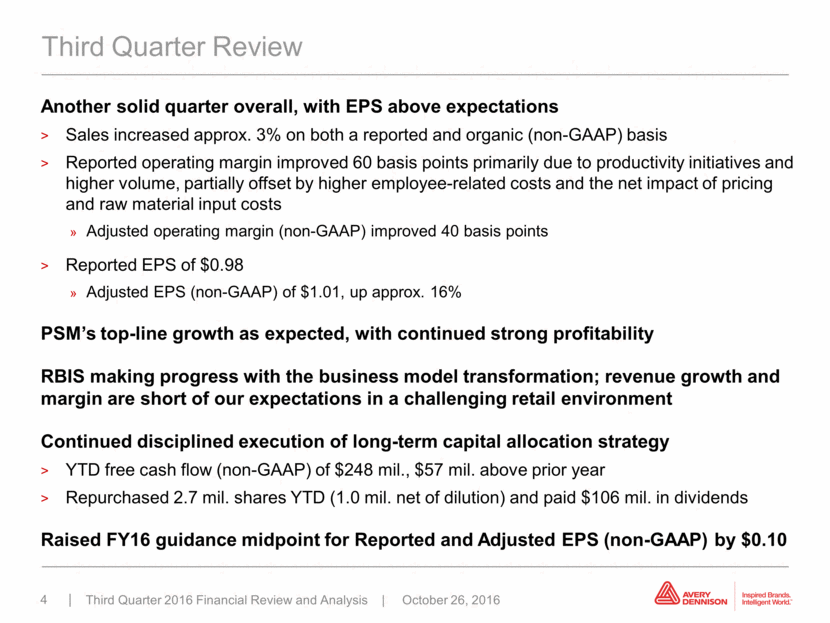
3Q15 4Q15 1Q16 2Q16 3Q16 Reported Sales Change (5.9)% (9.3)% (2.8)% 1.7% 2.8% Currency Translation 9.5% 8.0% 5.6% 1.7% 1.7% Acquisitions/Divestitures 1.0% 1.0% 1.0% 0.6% (1.8)% Extra Week -- ~7.5% -- -- -- Organic Sales Change* 4.6% 7.1% 3.8% 4.0% 2.7% Sales Trend Analysis * Totals may not sum due to rounding.
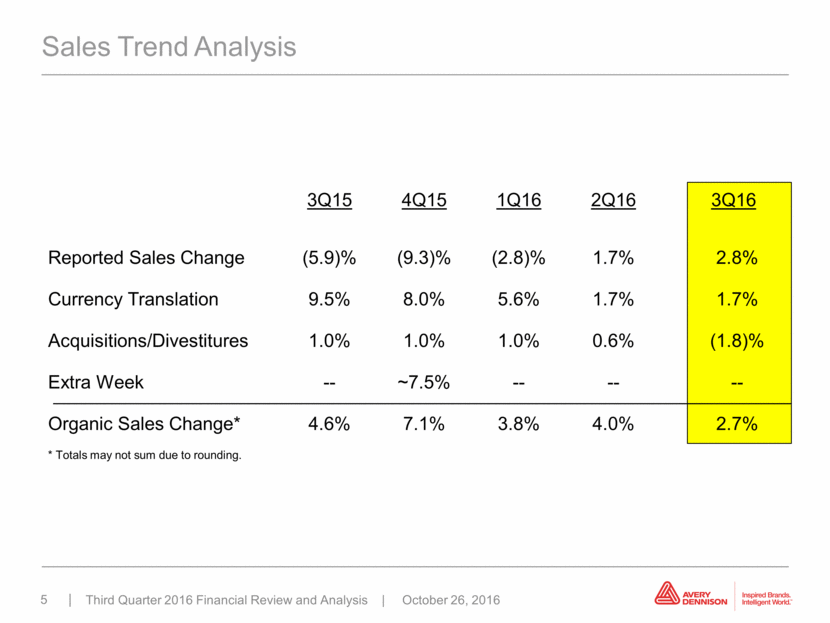
Third Quarter Segment Sales and Margin Analysis 3Q16 Reported Organic Sales Growth: Pressure-sensitive Materials 4% 3% Retail Branding and Information Solutions 1% 2% Vancive Medical Technologies (20)% (20)% Total Company 3% 3% Adjusted Reported (Non-GAAP) 3Q16 3Q15 3Q16 3Q15 Operating Margin: Pressure-sensitive Materials 12.3% 12.0% 12.6% 12.1% Retail Branding and Information Solutions 7.7% 6.8% 8.1% 7.9% Vancive Medical Technologies (6.4)% (6.8)% (3.6)% 2.8% Total Company 9.5% 8.9% 9.8% 9.4%
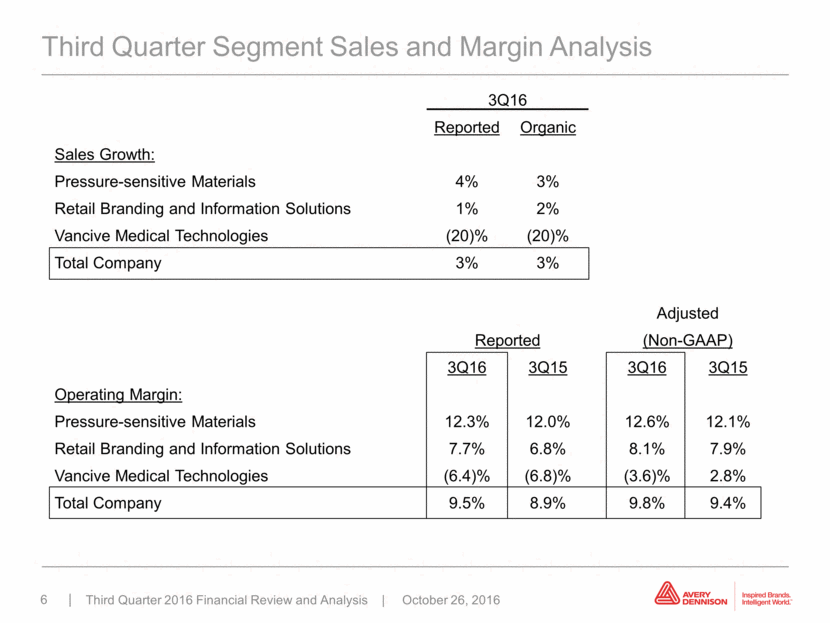
Third Quarter Segment Overview PRESSURE-SENSITIVE MATERIALS (PSM) Reported sales of $1.12 bil., up approx. 4% compared to prior year Sales up approx. 3% on organic basis Label and Packaging Materials sales up mid-single digits on organic basis Combined Graphics and Performance Tapes down low single digits on organic basis (up mid-single digits adjusted for expected program loss in Performance Tapes) Operating margin improved 30 basis points to 12.3% as the benefit of productivity initiatives and increased volume more than offset the net impact of price and raw material input costs and unfavorable mix Adjusted operating margin improved 50 basis points to 12.6% RETAIL BRANDING AND INFORMATION SOLUTIONS (RBIS) Reported sales of $371 mil., up approx. 1% compared to prior year Sales up approx. 2% on organic basis Operating margin improved 90 basis points to 7.7% primarily due to the benefit of lower restructuring charges Adjusted operating margin improved 20 basis points to 8.1% as the net savings associated with the business model transformation and higher volume were largely offset by higher employee-related costs
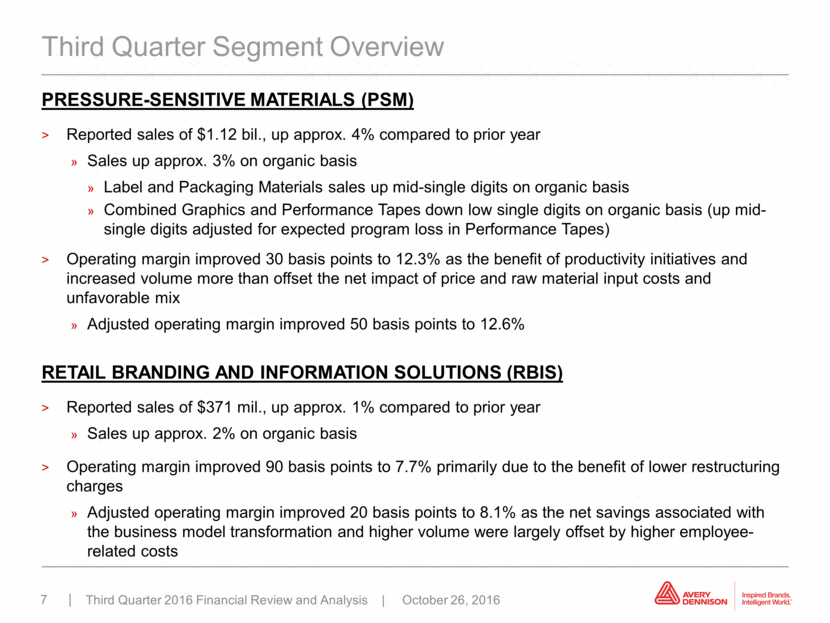
Contributing Factors to 2016 Results At recent currency translation rates, reported net sales up 1% to 1.5% (vs. previous assumption of 1% to 2%) Organic sales growth (non-GAAP) of 3% to 3.5% (vs. previous assumption of 3% to 4%) Based on recent rates, currency translation represents: ~2.5% reduction to reported net sales ~$16 mil. reduction to EBIT (vs. previous assumption of ~$18 mil.) RBIS product line divestiture headwind of (0.4)%, more than offset by PSM acquisition (Mactac) benefit of ~1% (immaterial impact to EPS) Incremental savings of more than $75 mil. from restructuring actions Tax rate of ~33% Average shares outstanding (assuming dilution) of ~90.5 mil. 2016 EPS Guidance Add Back: Est. restructuring charges and other items ~$0.15 Adjusted EPS (non-GAAP) Reported EPS $3.35 – $3.50 $3.80 – $3.95 Est. non-cash charge to settle certain U.S. pension obligations $0.30 Previous Updated $3.50 – $3.55 ~$0.15 $0.30 $3.95 – $4.00

[LOGO]
